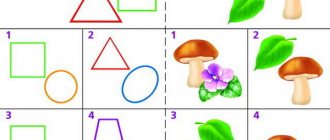Diagnosis of the sense of timbre
Test - game "Timbre hide and seek"
Purpose: to identify the level of development of timbre hearing in terms of adequately differentiated determination of the instrumental or vocal sound of the same melody.
The stimulating material is an audio recording of a musical fragment performed by:
children's voice; female voice; male voice; choir;
stringed bowed instruments; woodwind instruments; brass instruments;
piano; orchestra.
The child is asked to listen to an audio recording of a musical fragment in various performances and determine the timbre sound of the music.
Criteria for evaluation:
low level of development of timbre sense - adequate determination of only homogeneous timbres;
medium level - adequate definition of homogeneous timbres and mixed timbres; high level - adequate determination of various timbre relationships in the performance of the presented musical fragment.
Diagnosis of the sense of musical form
Test game “Unfinished Melody”
Goal: to identify the level of development of the sense of completeness (integrity) of musical thought.
Stimulating material is selected by the teacher independently.
The child is asked to listen to several melodies and determine which of them were heard in full and which were “hidden” ahead of time.
Stimulating material is constructed in the following order: 1st melody - the last bar is not played;
2nd melody - played to the end;
3rd melody - the last phrase of the melody is not played;
4th melody - interrupted in the middle of the second phrase (out of four); 5th melody - played to the end.
Criteria for evaluation:
weak level - 1-2 points are correctly identified; average level - 3-4 points are correctly identified; high level - all 5 points are correctly identified.
In the diagnosis of musical education and development of preschool children, two main directions can be distinguished: diagnosis of children’s musical abilities and diagnosis of children’s musical activity.
How is the musical abilities of a preschooler diagnosed in kindergarten?
§ 20. Diagnosis of children's musical abilities
The problem of diagnosing musical abilities remains the most relevant for modern psychological and pedagogical science, despite the fact that the first attempt to solve it dates back to 1883 and belongs to K. Stumpfon, the founder of music psychology. Why is this problem still relevant today?
Firstly, because the musical abilities themselves, the structure of a person’s musicality, still remain a problem.
Secondly, musical abilities are a complex combination of natural (innate), social and individual.
Thirdly, because the manifestation of abilities is always individual, which should be reflected in the diagnosis and interpretation of its results.
Fourthly, existing diagnostics require clarification in some cases, and in others, the search for new adequate diagnostic methods.
First of all, let’s clarify the role of diagnosing musical abilities, i.e., answer the question: what is it for?
The study of musical abilities will allow us to holistically and synthetically study the uniqueness of a child’s musicality and determine the individual path of its formation in kindergarten.
The purpose of diagnosing the musical abilities of preschoolers is associated with the study of the child’s musicality and the study of its individual structure. The diagnostic results will allow teachers to competently develop the child’s musical abilities in the logic of his individual development, his individual capabilities.
What approaches exist today to diagnosing the musical abilities of preschoolers?
In the diagnostics proposed by N.A. Vetlugina in the fifties of the last century, there are many ideas that require revival and return to modern kindergarten practice. For example, in the study of musical abilities, special attention was paid to the behavior of children, descriptions of their individual characteristics, manifestations of musicality, which were compiled by the teacher, observing the child in everyday life and in the process of musical lessons.
Diagnosis of emotional responsiveness to music
Test "Musical palette"
Purpose: to study the ability for emotional responsiveness to music, i.e. congruent experience and semantic reflection of the content of music.
Stimulating material: musical pieces from “Children's Album” by P.I. Tchaikovsky:
- "Morning Reflection"
- "Sweet Dream"
- "Baba Yaga"
- "Doll Disease"
- "Horse Game"
The child is invited to listen to these musical pieces and try to determine what mood each of them evokes in him, what images are imagined while the music is playing.
1st (verbal) version of the task: choose words suitable for the child to express his experience of music;
2nd (non-verbal-artistic) version of the task: the child is asked to draw images, pictures that appear to him while listening to music;
3rd (non-verbal-motor) version of the task: the child is asked to move to the music as he imagines it while the musical fragment is playing.
Criteria for evaluation:
A low level of emotional-imaginative comprehension is characterized by the child’s avoidance (actual refusal) from the projection of his states or his inability in a situation of musical influence to even the simplest self-expression of his impressions, mental images, moods in a non-verbal artistic, motor or verbal form. This level also includes incongruent forms of self-expression of a child in a situation of musical stimulation of his emotional experience;
the average (normative) level of development of emotional responsiveness is characterized by the ability to display in a congruently reproductive form the existing experience of experiences, states, mental images caused by the influence of a musical fragment; the child’s appropriate visual and verbal characterization of his experiences and mental images of the main content of the music (without special details of his display);
a high level of emotional responsiveness is characterized by a congruent characteristic of understanding the emotional and figurative content of music. The creativity of a child’s self-expression in visual, motor and verbal form is manifested in the following features of the form of self-expression:
originality (unusuality, novelty) of the display of a mental image, idea;
detailing (elaboration) of your idea or image;
fluency in generating ideas, i.e. the ability to generate a large number of new, but adequate to the musical impact of mental images;
flexibility, i.e. difference in types, types, categories of ideas and mental images for one musical material.
Diagnosis of dynamic feeling
Test - game “We will go to “Loud and Quiet””
Goal: determining the ability of an adequate auditory-motor reaction to dynamic changes (strength of expression) of instrumental and vocal-instrumental stimuli.
Stimulating material:
Drum or tambourine;
fragments of musical plays: H. Wohlfarth “The Little Drummer Boy”; K. Longchamp-Drushkevichova “March of Preschool Children”.
The child is invited to play “loud-quiet”. The teacher plays the piano, and the child
- on a tambourine or drum. The child is invited to play as the teacher plays: loudly or quietly. Adequate performance of contrasting piano-piano dynamics is assessed as 1 point. Then the teacher performs a musical fragment so that the sound of the music either intensifies or weakens; The child is asked to repeat the dynamics of the sound on a drum or tambourine. Adequate dynamic performance of “crescendo” and “diminuendo” is scored 2 points; total - 4 points.
Criteria for evaluation:
weak level of dynamic feeling - 1 point;
average level - 2-3 points; high level - 4-5 points.
Test tasks for diagnosing children's musical abilities
Preparation of test tasks for diagnosing children's musical abilities.
1) Sample tasks for determining modal sense, musical and auditory perceptions, sense of rhythm:
- to establish the level of development of the modal sense:
Exercise 1.
Observing the emotional perception of music. Talk about the content of the music. A conversation about the expressive meaning of dynamics. The nature of melodic intonations, expressive timbres of instruments, conveying the character of the music. You can ask children to depict the character of music in motion.
Task 2.
Composing a melody to a given text. Finish the melody on the tonic. You can use a question and answer form.
Task 3.
Exercises for distinguishing modes.
- to establish the level of development of musical and auditory perceptions
Exercise 1.
Find out the direction of movement of the melody up, down, in place (above or below) Answer on which word the melody changed. (For example, in the songs “Cornflower” or “Cockerel” r. n. melody).
Task 2.
Sing your favorite song, first with accompaniment, then without musical accompaniment. Purely intoning the melody.
Task 3.
Repeat a specially played unfamiliar melody.
- to establish the level of development of the sense of rhythm
Exercise 1.
After listening to a simple melody (8 bars), invite the children to tap its rhythm, and when performing it again, independently reproduce it by clapping or on children’s musical instruments.
Task 2.
After listening to the plays: “Moth”, “Polka”, “March”, S. Maikapara, children must portray a Moth (light, graceful and gentle); cheerful dance; decisive, important confident march.
Emotionally, rhythmically depict musical strokes - legato, staccato, non legato, feel accents, highlight phrases in movements. Give genre characteristics of musical works.
Task 3.
The teacher improvises on the piano. Feel changes in the character and tempo of the music, convey these changes in movements.
2) Test game “Timbre hide and seek”
Target:
identifying the level of timbre hearing by identifying the instrumental or vocal sound of the same melody
- Let's play musical hide and seek with you. Now the same melody will be performed by different voices. Listen and guess whose voice performed it the first, second, third time, etc.
An audio recording of the same melody sounds (for example, V. Vitlin “Little Gray Cat”), performed by the indicated instruments in the sequence: 1) piano, 2) guitar, 3) flute, 4) button accordion, 5) metallophone, 6) duets: guitar + triangle, 7) button accordion + tambourine, 8) xylophone, 9) trio: balalaika + button accordion + drum, 10) piano + button accordion + maracas.
Criteria for evaluation:
- weak level – adequate definition of the timbres of the first three fragments: total = 1 – 3 points;
- average level – adequate definition of the timbre of the first seven fragments performed: total = 4 – 7 points;
- high level – adequate determination of the timbre of a performed musical phrase within 8 – 10 presented fragments: total = 8 – 10 points.
3) Test game “We will go to “Loud and Quiet””
Target:
determination of the ability of an adequate auditory-motor reaction to dynamic changes (strength of expression) of instrumental and vocal-instrumental stimuli.
- Let's play loud and quiet with you. I play the piano and you play the drum. Play like me: I am loud and you are loud, I am quiet and you are quiet (A. Aleksandrov’s piece “Drum” is performed, adequate performance of the contrasting dynamics of which “forte - piano” is assessed at 1 point).
- And now the music will gradually increase or decrease. You will also need to perform it on the drum (E. Parlov’s play “March” is being performed, adequate dynamic performance of the 1st phrase in the dynamics of “crescendo” is estimated at 2 points and the 2nd phrase – “diminuendo” is estimated at 2 points. Total 4 points).
Stimulating material:
drum (or tambourine) and fragments of musical plays - A. Alexandrov “Drum”; E. Parlov “March”.
Criteria for evaluation:
- weak level of dynamic feeling = 1 point;
- average level = 2 – 3 points;
- high level = 4 – 5 points.
4)Test game “Unfinished Melody”
Target:
identify the level of development of the sense of completeness (integrity) of musical thought.
— Now the melodies will be “hidden”: some of them will sound in full, while others will not. Listen and try to determine which melody sounds until the end, and which one is “hidden” ahead of time?
After setting the key, any melody known to the child is performed, for example, “A Christmas tree was born in the forest,” in which the last sound is not played, interrupted by the words “green would...”.
Stimulating material
The diagnostic method can be selected independently by the diagnostician.
The method of using stimulating material is constructed in the following order:
1st melody – the last bar is not played;
2nd melody – played to the end;
3rd – the last phrase of the melody is not played;
4th – interrupted in the middle of the second phrase (out of four);
5th – played to the end.
Criteria for evaluation:
- weak level – 1 – 2 points are correctly identified;
- average level – 3 – 4 points are correctly identified;
- high level – all 5 points are correctly identified.
5)Cat and kitten
Target:
identify the level of formation of the sense of pitch - an adequate sense of the relationships between the pitches of sounds.
— The cat and the kitten were lost in the dark forest. Listen: this is how a cat meows (for example, the sound is played
1), and so – a kitten (a higher sound is performed, for example,
salt
1). Help them find each other. Tell me, when does a cat meow, and when does a kitten meow?
| Code tasks | Presented sounds (first octave, second octave) | Point awarded (for correct answer) | Correct answer |
| 1.1. | mi1 – sol2 | 1 | Cat - kitten |
| 1.2. | sol2 – fa1 | 2 | Kitten - cat |
| 1.3. | fa1 – fa2 | 3 | Cat - kitten |
| 2.1. | fa2 – salt1 | 1 | Kitten - cat |
| 2.2. | mi2 – salt1 | 2 | Kitten - cat |
| 2.3. | la1 – mi2 | 3 | Cat - kitten |
| 3.1. | la1 – re2 | 1 | Cat - kitten |
| 3.2. | re2 – si1 | 2 | Kitten - cat |
| 3.3. | do2 – si1 | 3 | Kitten - cat |
Test presentation algorithm:
First the task is given 1.3.
Next, if the answer is correct –
task 2.3.
, then –
task 3.3.
If the child’s answer turns out to be incorrect, the task is simplified -
1.2.
(where 2 points are awarded for the correct answer), if this task is also performed incorrectly,
task 1.1 is given.
(1 point). And so on for each block.
Criteria for evaluation:
- high level = 7 – 9 points (3+3+3; or 3+3+2; or 3+2+2);
- average level = 4 – 6 points (3+2+1; or 3+1+1; or 2+1+1);
- low level = 1 – 3 points (2+1+0; or 1+1+1; or1+1+0; or 1+0+0).




